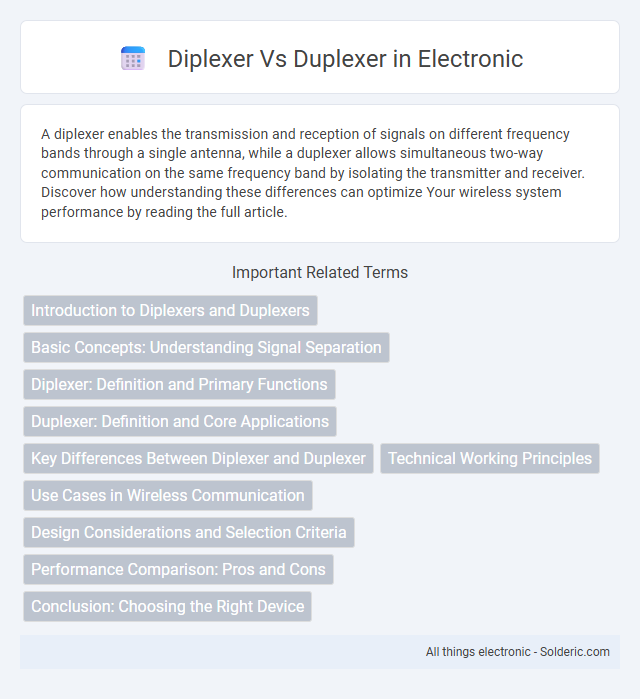A diplexer enables the transmission and reception of signals on different frequency bands through a single antenna, while a duplexer allows simultaneous two-way communication on the same frequency band by isolating the transmitter and receiver. Discover how understanding these differences can optimize Your wireless system performance by reading the full article.
Comparison Table
| Feature | Diplexer | Duplexer |
|---|---|---|
| Function | Combines or splits two frequency bands on a single antenna or transmission line | Allows simultaneous transmission and reception on a single antenna by separating transmit and receive signals |
| Frequency Usage | Uses distinct, non-overlapping frequency bands | Operates on the same or closely spaced frequency band for TX and RX |
| Application | Used in RF systems needing multiple frequency bands like TV or satellite systems | Common in radio communication devices and mobile radios for full-duplex operation |
| Isolation | Moderate isolation between frequency bands | High isolation required between transmitter and receiver |
| Complexity | Simpler design, typically passive filters | More complex, often using specialized resonant cavities or acoustic wave filters |
| Example | Separate TV and FM signals combined on one antenna | Handheld radio transmitting and receiving simultaneously on different channels |
Introduction to Diplexers and Duplexers
Diplexers and duplexers are essential RF components used to manage multiple frequency signals within communication systems, enabling efficient signal routing and isolation. A diplexer allows two different frequency bands to share a common antenna by separating or combining signals, while a duplexer enables simultaneous transmission and reception on the same antenna by isolating the transmitter and receiver paths. Understanding your system's frequency requirements and isolation needs is crucial in selecting between a diplexer and a duplexer for optimal performance.
Basic Concepts: Understanding Signal Separation
A diplexer uses frequency-selective filters to separate signals between different frequency bands, enabling multiple signals to share a single antenna without interference. A duplexer, commonly used in two-way radios, allows simultaneous transmission and reception on the same antenna by isolating the transmitter and receiver paths using specialized filters. Both devices are essential for signal separation but are optimized for distinct applications--diplexers manage distinct frequency bands, while duplexers handle bidirectional communication on the same frequency range.
Diplexer: Definition and Primary Functions
A diplexer is a passive device that enables two different frequency bands to share a single antenna by combining or separating signals without interference. Its primary function is to route high and low-frequency signals separately, optimizing the use of antenna resources in communication systems such as radio and cellular networks. Diplexers enhance signal efficiency by minimizing loss and ensuring isolation between frequency bands for simultaneous transmission and reception.
Duplexer: Definition and Core Applications
A duplexer is a device that enables simultaneous transmission and reception of signals on a single antenna by isolating the transmitter and receiver paths, commonly used in communication systems like radios and mobile phones. Core applications of duplexers include enabling full-duplex communication in wireless networks, improving signal quality, and reducing interference in duplex communication setups. Understanding the role of duplexers helps optimize Your wireless system's performance by ensuring efficient use of frequency bands.
Key Differences Between Diplexer and Duplexer
Diplexers separate signals based on frequency bands, enabling the simultaneous use of multiple channels on a single antenna without interference, commonly used in satellite and communication systems. Duplexers, designed to allow simultaneous two-way communication on the same frequency band, isolate the transmitter and receiver paths, essential in radar and transceiver devices. The primary difference lies in diplexers operating with different frequency bands, while duplexers manage separate transmission and reception signals within the same band.
Technical Working Principles
A diplexer separates or combines two signals at different frequency bands using passive filters, allowing shared use of a single antenna for transmitting and receiving without interference. A duplexer enables simultaneous transmission and reception over the same frequency band by employing highly selective filters that isolate transmitter and receiver paths. Both devices optimize antenna utilization but differ in working principles where diplexers filter by frequency bands while duplexers isolate by signal direction and timing.
Use Cases in Wireless Communication
Diplexers separate signals based on frequency bands, enabling simultaneous transmission and reception on different frequency channels, commonly used in base stations and cellular repeaters. Duplexers allow full-duplex communication by isolating transmit and receive paths within the same frequency band, critical in mobile phones and two-way radios. Both devices optimize spectrum efficiency but are chosen based on whether frequency division or same-frequency operation is required in wireless communication systems.
Design Considerations and Selection Criteria
Diplexer and duplexer design considerations revolve around frequency separation, insertion loss, and isolation requirements to optimize signal routing in communication systems. Selection criteria include the operating frequency bands, power handling capabilities, and the intended application, such as separating transmit and receive paths or combining multiple signals. Your choice depends on achieving minimal interference, ensuring compatibility with system specifications, and maintaining signal integrity.
Performance Comparison: Pros and Cons
Diplexers separate signals into two frequency bands with minimal insertion loss, ideal for combining or splitting transmit and receive paths in simple systems, but they lack isolation between ports, which can lead to interference. Duplexers provide superior isolation by using frequency-selective filtering, allowing simultaneous transmission and reception on the same antenna, enhancing performance in complex communication systems, though they generally introduce higher insertion loss and cost. Your system choice depends on whether you prioritize cost-effective signal separation with diplexers or high-isolation, full-duplex operation enabled by duplexers.
Conclusion: Choosing the Right Device
Selecting the right device depends on your specific communication needs: a diplexer combines two different frequency bands onto a single antenna, ideal for simpler setups with separate transmit and receive signals. A duplexer allows simultaneous transmission and reception on the same antenna by isolating frequencies within the same band, crucial for full-duplex systems like two-way radios. Understanding these distinctions ensures your system achieves optimal performance and efficiency.
Diplexer vs Duplexer Infographic

 solderic.com
solderic.com